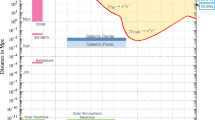Abstract
How the Sun shines has puzzled astronomers and biologists over the ages. The answer to this question led to a deeper understanding of an enigmatic particle, the neutrino, through the quantum mechanical phenomenon of neutrino oscillation. Neutrinos produced in various reactions change their type or ‘flavor’ as they propagate, and this requires them to possess a small but non-zero mass—they were earlier thought to be massless. The excitement in the area of studying neutrinos, about which we still know very little, led to the proposal for an India-based Neutrino Observatory (INO). We will review the physics of neutrinos, as well as the physics goals and current status of INO, in this article.
Similar content being viewed by others
Suggested Reading
J N Bahcall, M H Pinsonneault and S Basu, Solar models: Current epoch and time dependences, neutrinos, and helioseismological properties, Astrophys. J., Vol.555, pp. 990–1012, 2001. astro-ph/0010346[astro-ph].
M J Cush, Wikimedia Commons, https://conmons.wikimedla.org/wiki/File:Standard_Model_of_Elementary_Particles.svg.
D Indumathi, Our particle universe, Resonance, Vol.22, No.3, pp.245–255, 2017.
The Particle Adventure, The Fundamentals of Matter and Force, https://particleadventure.org/.
Dorottya Szam, Wikimedia Commons.https://commons.wikimedia.org/wiki/File:Proton_proton_cycle.svg.
J N Bahcall, A Serenelli and S Basu, New solar opacities, abundances, helioseismology, and neutrino fluxes, ApJ Letters, Vol.621, L85, 2005. arXiv: astro-ph/0412440v3.
Read about Ray Davis’ experiment here: https://www.sanfordlab.org/experiment/davis-experiment. Read more about solar neutrino experiments in the Nobel Prize website: https://www.nobelprize.org/prizes/physics/2002/press-release/.
Joachim Wolf, Measurement of muon induced neutron background at shallow sites, contribution to The Identification of Dark Matter, pp.458–463, 2002. arXiv:hep-ex/0211032.
Y Suzuki, The Super-Kaiokande experiment, Eur. Phys. J., 79, 298, 2019. https://doi.org/10.1140/epjc/S10052-019-6796-2.
Ghostly particle mystery ‘solved’, News about the solar neutrino measurements at the Sudbury Neutrino Observatory, BBC News, June 2001. http://news.bbc.co.uk/2/hi/science/nature/1394811.stm.
Stuart J. Freedman, Boris Kayser, The DNP/DPF/DAP/DPB joint study on the future of neutrino physics, APS multidivisional neutrino study, 2004. arXiv: physics/0411216[physics.pop-ph].
M Aker et al. (KATRIN Collaboration), An improved upper limit on the neutrino mass from a direct kinematic method by KATRIN, Phys. Rev. Lett., Vol.123, p.221802, 2019. https://doi.org/10.1103/PhysRevLett.123.221802.
Cora Dvorkin et al., The Astro 2020 Science White Paper on Neutrino Mass from Cosmology: Probing Physics Beyond the Standard Model, 2019. arXiv, astro-ph/1903.03689.
I. Esteban et al., The fate of hints: Updated global analysis of three-flavor neutrino oscillations, Journal of High Energy Physics, 178, 2020. https://doi.org/10.1007/JHEP09(2020)178.
S Ahmed et al., Invited review: Physics potential of the ICAL detector at the India-based Neutrino Observatory (INO), Pramana, Vol.88, No.79, 2017.
Bringing neutrino research back to India, Symmetry Magazine, June 2015. https://www.symmetrymagazine.org/article/june-2015/bringing-neutrino-research-back-to-india.
Game changing neutrino experiments, Symmetry Magazine, May 2018. https://www.symmetrymagazine.org/article/game-changing-neutrino-experiments.
Neutrinos could shed light on why the Universe has so much more matter than antimatter, Nature (Editorial), 580, 305, April 2020, https://doi.org/10.1038/d41586-020-01022-3.
Acknowledgements
I thank B. Satyanarayana for generous permission to use the photos on mini-ICAL, RPCs, etc., in this article. I thank V. M. Datar and M. V. N. Murthy for their critical reading of the manuscript, which enormously improved its quality and content. I also thank Dhruba Saikia for inviting me to write this article, a most difficult task in the present circumstances.
Author information
Authors and Affiliations
Additional information
D. Indumathi works on the phenomenology of particle physics at The Institute of Mathematical Sciences, Chennai. Her interests are in both the field of strong interactions and neutrino physics and she is actively involved with the proposed India-based Neutrino Observatory. She has been a part of science popularisation activities for both school and college students for a long time.
Rights and permissions
About this article
Cite this article
Indumathi, D. Neutrinos and the Proposed India-based Neutrino Observatory. Reson 27, 185–205 (2022). https://doi.org/10.1007/s12045-022-1308-3
Published:
Issue Date:
DOI: https://doi.org/10.1007/s12045-022-1308-3




